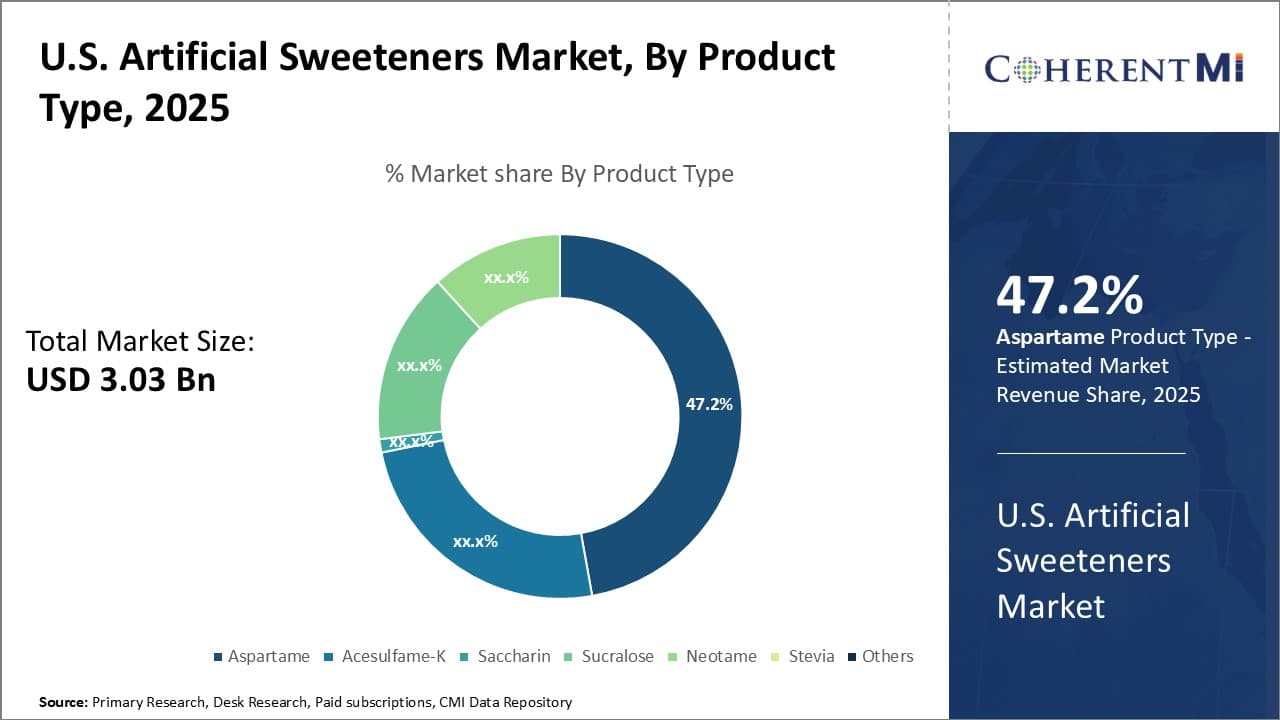

U.S. artificial sweeteners market is expected to be valued at US$ 3.03 Bn in 2025, and is expected to reach US$ 4.77 Bn by 2032, exhibiting a compound annual growth rate (CAGR) of 6.7% from 2025 to 2032.
Artificial sweeteners, also known as non-nutritive sweeteners or intense sweeteners, are substitutes for sugar with low or no calories. These are synthesized in laboratories, and are sweeter than table sugar. The major types of artificial sweeteners include aspartame, acesulfame K, saccharin, neotame, and sucralose. Artificial sweeteners provide the sweetness of sugar without the high amount of calories, thus, making them attractive alternatives for weight management, diabetes control, and dental health.
U.S. artificial sweeteners market growth is driven by rising health consciousness among consumers, growing prevalence of obesity and diabetes, and surging demand for low-calorie food and beverages. The market is segmented into by product type, application, form, and distribution channel. By product type, the aspartame segment held the largest share in 2025, owing to its widespread use in beverages and convenience foods.
U.S. Artificial Sweeteners Market- Drivers
U.S. Artificial Sweeteners Market- Opportunities
U.S. Artificial Sweeteners Market- Restraints
Market Size in USD Bn
CAGR6.7%
| Study Period | 2025-2032 |
| Base Year of Estimation | 2024 |
| CAGR | 6.7% |
| Larget Market | U.S. |
| Market Concentration | High |
| Major Players | Cargill, Archer Daniels Midland, Tate & Lyle, Ajinomoto Co. Inc., Celanese Corporation and Among Others |
Increasing adoption in confectionery, bakery and dairy items: Historically, the usage of high-intensity sweeteners was limited to beverages and tabletop sweeteners. However, their application is rising across confectionery, bakery and dairy products. Manufacturers are using sweeteners in chocolate, ice cream, yogurt, cakes, muffins, frosting, and others to develop low-sugar alternatives. For instance, brands like Halo Top have gained popularity for their low-calorie artificial sweetener-based ice creams. Rising demand for sweetener-based desserts and bakery items among diabetics and weight watchers is a trend that boosts product adoption.
Demand for sweetener blends over single sweeteners: Food and beverage manufacturers are increasingly using combinations of artificial sweeteners rather than single sweeteners to achieve well-rounded taste profiles. Blends provide synergistic effects resulting in enhanced sweetness potency and sensory experience. For instance, stevia is often blended with aspartame, sucralose or monk fruit extracts. The use of combinations of sweeteners also makes it possible to reduce the dosage of individual sweeteners, which promotes this development. Companies like ADM, Cargill and Tate & Lyle offer blended sweetener solutions.
Clean label and natural sweetener solutions: With rising consumer demand for clean label and natural products, manufacturers are offering ingredients like stevia and monk fruit to replace artificial sweeteners like aspartame or acesulfame K. Consumers are increasingly scrutinizing product labels and seeking recognizable and natural ingredients. Stevia and monk fruit provide the sweetness of sugar without artificial additives. Brands across categories like beverages, dairy, snacks, and others are reformulating products with these natural sweetening solutions, thus, fueling their adoption.
Surging popularity of stevia sweeteners: Among high-intensity sweeteners, stevia has witnessed exponential growth in demand and adoption rates owing to its natural origin. According to Innova Market Insights Data in 2021, stevia was used in over 35% of food and beverage launched in 2021. Consumers perceive it as a healthy, plant-based alternative with no calories and glycemic impact. Manufacturers are using premium quality stevia extracts like reb M and reb D optimized for taste. The rising consumer preference for stevia as a sugar substitute is a noteworthy trend in the industry.
 To learn more about this report, Download Free Sample Copy
To learn more about this report, Download Free Sample CopyImperial Sugar Company, Cumberland Packing Corp., NOW Foods, Ajinomoto Co. Inc., Celanese Corporation, JK Sucralose Inc., Hermes Sweeteners Ltd., Merisant Company, DuPont, Niutang Chemical Ltd., SweetLeaf, Pyure Brands, Cargill, Archer Daniels Midland, Tate & Lyle, PureCircle, Stevia First Corporation, Wisdom Natural Brands, Xinghua Green Biological Engineering Co. Ltd., GLG Life Tech Corporation
New Product Launches
Acquisition and partnerships
Would you like to explore the option of buying individual sections of this report?
Sakshi Suryawanshi is a Research Consultant with 6 years of extensive experience in market research and consulting. She is proficient in market estimation, competitive analysis, and patent analysis. Sakshi excels in identifying market trends and evaluating competitive landscapes to provide actionable insights that drive strategic decision-making. Her expertise helps businesses navigate complex market dynamics and achieve their objectives effectively.
U.S. Artificial Sweeteners Market is Segmented By Product Type (Aspartame, Acesulfame-K, Saccharin, ...
U.S. Artificial Sweeteners Market
How big is the U.S. Artificial Sweeteners Market?
The U.S. Artificial Sweeteners Market is estimated to be valued at USD 3.0 in 2025 and is expected to reach USD 4.8 Billion by 2032.
What are the major factors driving the U.S. artificial sweeteners market growth?
Rising health consciousness and obesity rates, growing diabetes prevalence, demand for low-calorie food and beverages, innovation in taste, flavor and sweetness, and increasing disposable incomes are expected to drive the market growth.
Which is the leading component segment in the U.S. artificial sweeteners market?
The leading component segment in the U.S. artificial sweeteners market is powder.
Which are the major players operating in the U.S. artificial sweeteners market?
The major players operating in the market include Imperial Sugar Company, Cumberland Packing Corp., NOW Foods, Ajinomoto Co. Inc., Celanese Corporation, JK Sucralose Inc., Hermes Sweeteners Ltd., Merisant Company, DuPont, Niutang Chemical Ltd., SweetLeaf, Pyure Brands, Cargill, Archer Daniels Midland, Tate & Lyle, PureCircle, Stevia First Corporation, Wisdom Natural Brands, Xinghua Green Biological Engineering Co. Ltd., GLG Life Tech Corporation
What will be the CAGR of U.S. artificial sweeteners market?
The U.S. artificial sweeteners market is projected to exhibit a CAGR of around 6.7% from 2025 to 2032.